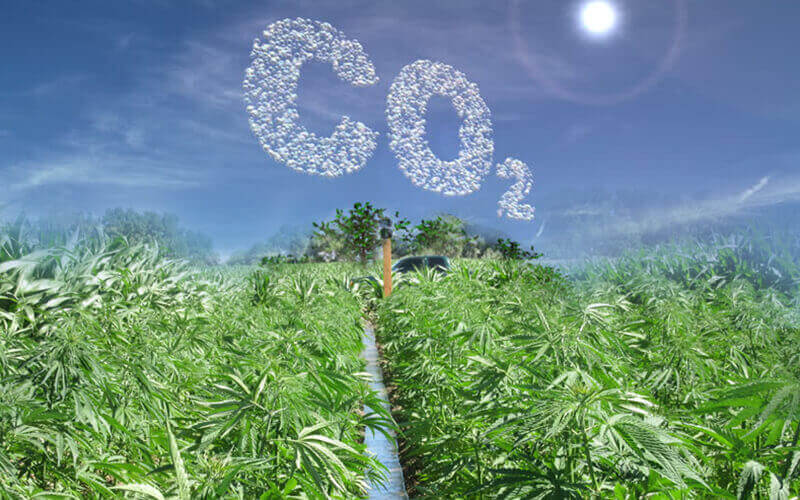How Hemp Can Reduce Carbon Dioxide in the Air
Carbon footprint: a phrase we hear almost as often as we hear global warming and climate change. Not surprising, as all of them are connected. Climate change is a threat to the future of planet earth. Global warming is one of the major factors behind climate change. Increased carbon emission is one of the core reasons for global warming. In this article, we will discuss how hemp can help us reduce carbon dioxide and fight against global warming.
Carbon here refers to gas carbon dioxide or CO2. Human activities since the industrial revolution, and especially since the mid-20th century, has been consistently increasing the level of CO2 released into the earth’s surface. Hence the phrase ‘carbon footprint’. Today, the amount of CO2 in the earth’s atmosphere is much higher than what it would be naturally.
CO2 and the Greenhouse Effect
Higher levels of CO2 and some other gases in the earth’s atmosphere cause the greenhouse effect. A greenhouse is a structure built entirely of glass, used in gardening to grow plants that need warm weather. The typical use of greenhouses is for growing tropical flowers, fruits, and vegetables in places where the natural weather is cooler than these plants need.
A greenhouse maintains warmth 24X7 even during winter. The sunlight passes through the glass structure easily and warms the air inside during the day. The glass walls and ceilings trap the heat so that the warmth lingers through the night also.
Higher CO2 levels in the atmosphere have just this effect on the earth. CO2 traps the heat and increases temperature levels on the earth’s surface. It is like the whole planet is inside a greenhouse.
Why Does It Matter?
The official website of the climate department of the US government mentions that the current atmospheric CO2 level is higher than it has ever been in the last 800,000 years. In 2018, the CO2 level on the earth’s surface reached 407.4 parts per million, a record high after three million years.
Unless we control the greenhouse effect on the earth’s atmosphere, CO2 levels are likely to cross 900 parts per million by the end of the 21st century. Higher levels of thermal energy trapped on the earth’s surface imply that the planet is warmer than it would be naturally.
So what if we live in a warmer planet? Well, for one, it causes the polar ice to melt faster than it gets replaced. The Arctic and Antarctic icecaps play a critical role in keeping our landmass intact. If these icecaps get damaged, all coastal areas in the world will be submerged.
Here is a photo of the Arctic ice sheet at its peak in winter on 13 March 2019. It is the seventh-lowest in 40 years.
Source:carbonbrief
Ocean and sea levels are rising because of global warming. That is another threat to losing coastal areas to water bodies. Also, the natural habitat of flora and fauna gets affected and so does the overall ecological balance. Also, our oceans are already 30% more acidic because of absorbing excessive CO2.
The threats are many and varied. One way out is to explore outer space for creating new human settlements there. But a much more practical solution is to look for natural responses to reduce the greenhouse effect.
Why Hemp Counts
The hemp, or industrial hemp as it is also called, the plant is a natural solution to much of the excessive CO2 emission issue. It is an amazingly versatile plant that had been in human use for thousands of years. It is only in the 20th century that we declared it an outlawed plant in many countries of the world.
A simple act of omission caused this (though there are conspiracy theorists who believe that it was more an act of commission). Psychoactive cannabis or marijuana is a cousin of the hemp. They both belong to the same plant species, Cannabis Sativa. But hemp does not have the psychoactive properties of its cannabis cousin.
Tetrahydrocannabinol (THC) is the chemical that gives marijuana its capacity to cause a “high”. But the THC level in the industrial hemp is limited to 0.3%. That is why this plant does not have the psychoactive capacity of cannabis the drug.
The hemp has a number of benefits for human beings and the environment we live in. Reducing our carbon footprint is only one of them.
Fossil Fuels vs. Hemp Biofuel
Much of the excess CO2 in the earth’s atmosphere is because of our dependence on fossil fuels like petrol and diesel. Hemp biofuel is one of the most easily available renewable energy sources that we can use to substitute fossil fuels.
A 2010 report from the University of Connecticut, USA, reports on a research initiative led by Richard Parnas, professor of biomolecular, chemical and materials engineering at the university. According to the findings of this research, industrial hemp is a feasible source of producing biodiesel.
One of the main advantages of using hemp for producing biodiesel is that the plant grows on infertile soil not suitable for cultivating other crops, especially foodgrains. It is an easy-to-grow plant that needs no additional fertilizers and is naturally resistant to pests.
The research report states that hemp seeds are naturally rich in oil content and 97% of that can be used to generate biodiesel. Hemp biofuel can also be used at temperatures lower than other plant-based fuels presently in use.
Hemp Can reduce Carbon Dioxide
Planting more trees is an effective means of addressing the carbon emission issue, for plants absorb carbon dioxide. Hemp is a plant with a particularly high level of efficiency in this regard. Experts say that every ton of hemp can sequester 1.62 tons of CO2. In simple language, that is how much CO2 a ton of hemp can trap and hold.
Hemp can also reintegrate CO2 back into the soil through biosequestration. This is a process of smoldering a harvested plant slowly. Harvested hemp produces charcoal-like biochar when smoldered slowly post-harvest. To mix this biochar with the soil is to return the carbon to the soil, rather than releasing it into the atmosphere.
Hempcrete Reduces Carbon Emission
A recent report from the United Nations Environment Program mentions that the construction industry is responsible for up to 30% of the total greenhouse gas emissions globally. This industry also accounts for about 40% of the total global energy consumption.
Using hempcrete as insulation for buildings can reduce carbon dioxide emissions considerably. A 2010 report by the Department for Business, Innovation & Skills, Government of UK, mentions that one square meter of hempcrete wall framed by timber can store up to 35.5 kg of CO2. That is after absorbing the energy cost of transportation and assembling of the materials.
Hempcrete is a biocomposite made of hemp hubs, water, and lime or some other natural binder. Hemp hubs or shives are the inner core of hemp stalks left after the outer fibers have been taken out. These hubs are woody in texture. Hempcrete is not strong enough for load-bearing, but they are effective for insulation.
Hempcrete insulation also reduces energy consumption for insulating buildings as it is naturally breathable. It can both store thermal energy and release it, which makes it suitable for different temperature zones.
Think Hemp for a Greener Planet
There are myriad other ways that hemp can help us find natural solutions to the climate change menace. Reducing our carbon footprint is only one of them. It is time we started relying more on the ancient wisdom associated with the use of this miracle plant.





